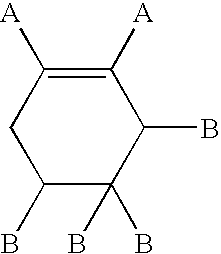Process for triggering, storing, and distributing an oxygen scavenger, and a stored oxygen scavenger
a technology of oxygen scavenger and process, which is applied in the direction of hydrogen, water/sewage treatment by substance addition, and containers preventing decay. it can solve the problems of deterioration in the presence of oxygen, food products such as meat and cheese, smoked and processed luncheon meats, and the development of rancidity
- Summary
- Abstract
- Description
- Claims
- Application Information
AI Technical Summary
Benefits of technology
Problems solved by technology
Method used
Image
Examples
example 1
[0068]An oxygen scavenger film was produced having the following structure:
[0069]
Layer 1Layer 2Layer 3Layer 4Layer 5Layer 60.250.150.52.000.10.54
[0070]The thickness of each layer is indicated in the above table. The total thickness of the film was 3.54 mils.
[0071]Compositionally, each layer was formulated as follows:
[0072]Layer 1 was a blend of 60%, by weight of the blend, of an single site catalyzed ethylene / hexene copolymer, and 40%, by weight of the blend, of a polyethylene-based silica / antioxidant masterbatch.
[0073]Layer 2 was a blend of 50%, by weight of the blend, of a propylene / ethylene copolymer, and 40%, by weight of the blend, of a ethylene / methyl acrylate copolymer.
[0074]Layer 3 was a blend of 45%, by weight of the blend, of an ethylene / vinyl acetate copolymer, 40%, by weight of the blend, of a styrene / butadiene copolymer, and 15%, by weight of the blend, of an ethylene / vinyl acetate copolymer-based masterbatch containing a photoinitiator and a transition metal catalyst.
[...
example 2
[0092]An oxygen scavenging multilayered film like Example 1 was triggered on a CRYOVAC® 4104V triggering unit. In this film, layer 3 was 90% poly(ethylene-methyl acrylate / cyclohexene-methyl acrylate) (EMCM) available from Chevron-Phillips, and 10% ethylene / methyl acrylate (EMA) masterbatch containing photoinitiator and transition metal catalyst with a thickness of 0.75 mil. Layer 4 was 100% LLDPE with a thickness of 1.5 mil. Layers 1 and 2 were both a blend of 94% LLDPE and 7% antiblock masterbatch with a total thickness of 0.25 mil. All four light banks were activated, and film was run at a speed of 10 feet per minute, providing a dose to the film of about 712 mJ / cm2. Triggered film was cut into 10×10 cm pieces. This triggered film was wrapped on 3 inch cores, vacuum packaged twice in Cryovac TBG™ bags, and placed in 9×16 inch foil bags (Georgia Packaging Inc., FOIL-O-RAP™ 2175-B). Bags were vacuum packaged and sealed, and stored in the dark at 75° F. for 24 hours.
[0093]Bags were t...
example 3
[0098]The triggered film of example 2 in the form of a roll was vacuum packaged in Cryovac barrier bags, and placed in a Styrofoam cooler surrounded by dry ice (˜−78° C.). The triggered film was stored in that state for up to 7 days. Samples of film were tested without storage (time zero) and at 1, 2, 3, 4, and 7 days. For testing scavenging activity, triggered film was cut into 10×10 cm pieces and vacuum packaged in 9×16 inch foil pouches (Georgia Packaging Inc., FOIL-O-RAP™ 2175-B). The pouches were inflated with 3050 cc of nominally 1% oxygen atmosphere. Residual headspace oxygen was measured using the Mocon PACCHECK™ 400 at various times through 64 days of testing at room temperature.
[0099]The average oxygen scavenging rate is calculated by considering only the end points, with the following formula: Average Rate=cc O2 scavenged / (m2·day), and in these examples was calculated about 4 days after UV triggering. The peak (instantaneous) rate is the highest scavenging rate observed d...
PUM
| Property | Measurement | Unit |
|---|---|---|
| temperatures | aaaaa | aaaaa |
| temperatures | aaaaa | aaaaa |
| storage temperatures | aaaaa | aaaaa |
Abstract
Description
Claims
Application Information
 Login to View More
Login to View More - R&D
- Intellectual Property
- Life Sciences
- Materials
- Tech Scout
- Unparalleled Data Quality
- Higher Quality Content
- 60% Fewer Hallucinations
Browse by: Latest US Patents, China's latest patents, Technical Efficacy Thesaurus, Application Domain, Technology Topic, Popular Technical Reports.
© 2025 PatSnap. All rights reserved.Legal|Privacy policy|Modern Slavery Act Transparency Statement|Sitemap|About US| Contact US: help@patsnap.com

